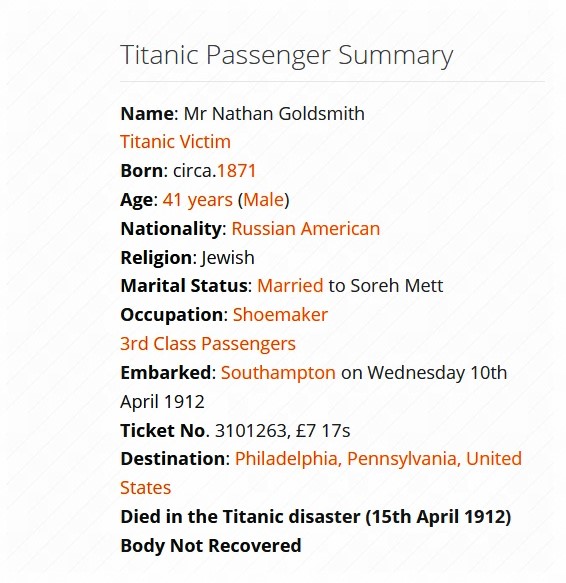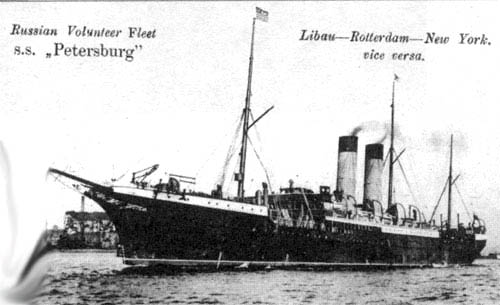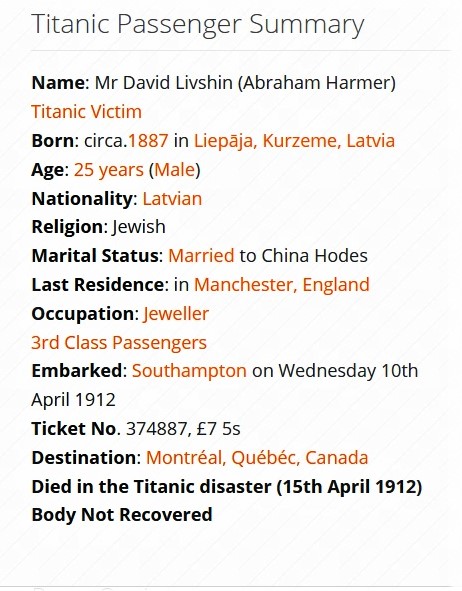Two Latvian-born passengers also went on the first and last voyage of the Titanic
With a 7-pound 17-shilling and 11-pence worth third-class ticket in one hand and a small piece of luggage in the other, in 1912 Nathan Goldsmith boarded the passenger liner Titanic in Southampton. David Livshin also had a third-class ticket – however, issued in the name of Abraham Harmer. N. Goldsmith and D. Livshin are the only known passengers on this fateful flight who were born in Latvia. 109 years ago, on April 15, the Titanic sank, taking the lives of hundreds of people.
Nathan Goldsmith (referred to in the Titanic documents as Nathan (Neshenye) Goldsmith) could no longer be considered a Latvian resident in 1912 because in 1907 the Goldsmith family left Latvia in the hope of a better life beyond the ocean. David Livshin also lived in England for a year before boarding the Titanic.
Thrown around by fate
Seven years ago, when "Titanic The Exhibition" visited Riga, the organizers of the exhibition, through Antra Salcēviča, tried to find a member of the Goldsmith family or at least someone who would have information about this family when it lived in Latvia. Antra Salcēviča regretfully told Neatkarīgā that it had not succeeded. So far no one has applied.

Nathan Goldsmith was born in 1871 in Kreitzburg (now Krustpils). In 1897, he married Soreh in Lithuania, in Panevėžys (at least according to encyclopedia-titanica.org). On July 9, 1898, the Goldsmith family welcomed its firstborn son Michael. Nine years later, in 1907, Nathan, along with his wife, son and Soreh's mother, Mina Mett, crossed the ocean with the steamer Petersburg from the port of Liepāja to New York in America. The family settled in Philadelphia, where Soreh's brother already lived. Nathan began working as a shoemaker. But because it was difficult to earn a living (another child was born in the family - son Irving), in 1909 he went to Johannesburg in South Africa to earn money, where he also worked as a shoemaker. From there he sent his wife money every Monday, but in 1912 he had written that he had decided to return home to Philadelphia. The road home was long and unfortunately ended tragically.
In the beginning, Nathan sailed for England, hoping that it would be easier to get to Philadelphia from there. But the miners were on strike at the time, and the only way to get to America was to go on the Titanic. He wrote a letter to his wife that he would arrive in New York on a ship called the Titanic. The wife received this letter the day before the disaster.
There was little hope of escape for third-class passengers, especially if they were men. Nathan Goldsmith's name is among those lost in the Titanic disaster.
After the loss of her husband in the Titanic disaster, Soreh became desperate, especially because one of the children was ill and Soreh's mother was no longer in good health. The family lacked any means of subsistence. The Red Cross archive card shows that the organization helped the Goldsmith family after the sole breadwinner died on the Titanic. The Red Cross paid a small family allowance until the eldest son finished school and could start working himself.

Ticket under a different name
Encyclopedia-titanica.org has compiled news about all Titanic passengers. Nathan Goldsmith was counted among the passengers from Russia. Probably because in 1912 Latvia was a part of the Russian Empire. At the same time, encyclopedia-titanica.org reports that there was one Latvian on board the Titanic - David Livshin, who was traveling in the 3rd class, moreover, with a ticket under a different name (I wonder if the screenwriters of the film Titanic had not borrowed the idea of a different name on a ticket from our compatriot)

David Livshin was born around 1887 in Liepāja, Kurzeme. The details of David's early life are unclear, but as far as can be ascertained, he served in the Russian army. In 1911 he moved to Manchester, England. He married in 1912 and decided to move with his wife to Canada, where David's brothers and sisters already lived. As his wife was expecting a baby, David went first to settle down and later take his wife with him.
David boarded the Titanic with a ticket purchased in the name of Abraham Harmer. This fact only came to light after the disaster and his wife was surprised. David had somehow concealed this fact.
On September 3, 1912, his son was born, who was also named David in honor of his father. He became a doctor when he grew up. In 1948 he married Milly Bor (1916-1998). They had three children, a son Michael (born 1949) and two daughters Naomi (born 1953) and Deborah (born 1957).
The lure of the Titanic
In 2001, news spread to the Latvian media that one of the children who survived the Titanic disaster could be Fredis Kārkliņš, who lived in Dzelzava parish. F. Kārkliņš had told his daughter that he, as a three-year-old child, had probably been on board the Titanic and had survived the disaster with his parents. Fredis Kārkliņš's father left for America in 1905 to earn money, where he met his future wife, they got married and after some time a son was born - Fredis. At an early age, he revealed to his daughter that in 1912 the family had embarked on the fateful Titanic trip. In 2001, when F. Kārkliņš was over 90 years old, he still vividly remembered several details, such as a pacifier that had fallen into the sea, the iceberg. The rest is remembered from his father's story - about escaping and getting to the ship Carpathia by boat, as well as how they later got to London, then to Latvia with the ship Louisiana. No evidence for this story has been found so far - there is no Kārkliņš family in the Titanic passenger list, and there is no family among the survivors with a three-year-old boy whose surnames are at least remotely similar to the Latvian Kārkliņš.
Latvian travelers were not excited about the Titanic
The passenger liner Titanic belonged to the British company White Star Line. Nowadays, it seems absolutely unbelievable, even surreal, the fact that at the beginning of the 20th century one of the offices of this company was also located in Liepāja, moreover, in the very center of the city, on the corner of Lielā and Šaurā streets, writes Vakara Ziņas. According to Kristīne Jākabsone, a researcher of Liepāja's cultural history, the building has unfortunately not survived - it was destroyed during the bombing of the Second World War. Nowadays, Šaurā Street is located in another part of the city, but historically it crossed the city's central street - Lielā Street. Now that location has an unnamed street section at the end of the central building of Liepaja University.
Most likely, no Latvian resident had bought a ticket in this office for the first and last Titanic voyage, because those who wanted to cross the ocean could use a much more convenient way. Namely, in 1906, a direct traffic line Liepāja-New York was opened, to which the Canadian port Halifax was later added. For example, the Russian East Asiatic Steam Ship Co's Kursk steamer was able to reach New York in two weeks. However, it is possible that a traveler who boarded the Titanic had previously gone to England from the port of Liepāja. On April 5, 1912, Liepājas Atbalss reported that emigrants were on board, thus it is possible that one of them got on board traveling through Liepāja.
The Titanic passenger register states that there was one Latvian (David Livshin), three Lithuanians, 19 Russians (among them Nathan Goldsmith) on board.
*****
Be the first to read interesting news from Latvia and the world by joining our Telegram and Signal channels.
